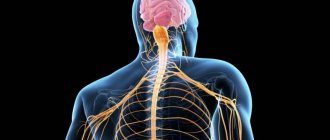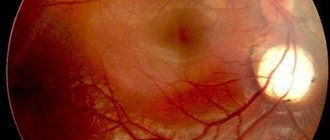By etiology:
- Infectious;
- Infectious-allergic (for childhood exanthema infections: measles, rubella, etc.);
- Toxic;
- Allergic (vaccinal, serum, etc.);
- Dysmetabolic: with vitamin deficiency, with endocrine diseases (diabetes mellitus), etc.;
- Discirculatory: for rheumatic and other vasculitis;
- Idiopathic and hereditary (neural amyotrophy of Charcot-Marie, etc.);
- Compression-ischemic lesions of individual peripheral nerves;
- Vertebrogenic lesions (bone, disc, joint, muscle and tendon-ligament formations).
Diseases of the peripheral nervous system of various etiologies can be primary (Guillain-Barré polyneuritis, leprosy, syphilis, leptospirosis, etc.) and secondary (vertebrogenic, after childhood exanthemal infections, infectious mononucleosis, periarteritis nodosa, rheumatism, etc.).
Neuralgia is painful sensations in the area of innervation of certain nerves and the formation of trigger zones of the skin and mucous membranes, irritation of which, for example, touch causes another attack of pain. In the intervals between attacks, neither subjective nor objective symptoms of irritation or loss of function of the affected nerve are observed.
The most common symptoms of damage to the peripheral nervous system:
- viral (Guillain-Barré polyneuritis, viral diseases, influenza, sore throat, infectious mononucleosis, etc.);
- microbial (for scarlet fever, brucellosis, syphilis, leptospirosis, etc.);
- for chronic intoxication (alcoholism, manganese, lead, etc.);
- for toxic infections (botulism, diphtheria);
- blastomatous (for lung cancer, stomach cancer, etc.);
- sensory disturbances (pain, numbness, feeling of fullness, “crawling”, increased or decreased sensitivity of certain areas);
- movement disorders (weakness, impaired motor function of the limbs, facial muscles and eyes);
- vegetative disorders (dry or wet hands and soles, cold extremities).
Lesions of the peripheral nervous system
Among the diseases that affect the nervous system, the following varieties are distinguished: multiple mononeuropathies , focal mononeuropathies , polyneuropathies .
With the development of focal neuropathies, an individual nerve, plexus, part or root is affected. Such damage occurs due to injury, severe compression or other factors. As a result, motor , sensory and autonomic .
With multiple mononeuropathy, not one, but several nerve trunks are simultaneously affected. The defeat does not occur symmetrically. As a rule, this pathology is observed in patients with vasculitis , neurofibromatosis , hypothyroidism , sarcoidosis , etc.
With polyneuropathy , symmetrical damage to peripheral fibers is observed, which is diffuse in nature. Among the causes of polyneuropathy are inflammatory damage to the nervous system, serious disturbances in nutrition and metabolism, and endogenous intoxications. Polyneuropathies also develop in patients with systemic and infectious diseases as a consequence of vaccination. This systemic disease is often observed in patients with diabetes mellitus and chronic alcoholism .
Diagnosis of diseases of the peripheral nervous system:
Methods for diagnosing diseases of the peripheral nervous system are aimed at identifying and correcting the underlying disease (for example, damage to peripheral nerves in diabetes mellitus requires correction of the underlying disease). An X-ray examination is carried out to identify the severity of degenerative-dystrophic changes in the spine, which are most often the causes of pain and discomfort in the back and limbs, to exclude pathological changes in bone tissue (including fractures).
For some pathologies, an MRI study may be indicated, which is aimed at identifying a pathological process that interferes with the normal functioning of the nerve fiber: for example, radiculopathy due to compression of the nerve root by an intervertebral hernia, neuromas, identifying congenital anomalies, etc.).
Structure of the peripheral nervous system
peripheral nervous system connects the human organs and limbs to the central nervous system. PNS neurons are located in the body outside the central nervous system, that is, the spinal cord and brain.
The human peripheral nervous system does not actually have the same protection as the central nervous system, so it can be exposed to toxins and also be damaged mechanically. Consequently, diseases of the peripheral nervous system are relatively common. Their treatment, as well as the treatment of diseases that affect the central nervous system, must be carried out immediately. It is customary to subdivide the peripheral nervous system into the somatic nervous system and the autonomic nervous system .
The peripheral part of the human nervous system has a certain structure. It is composed of ganglia , nerves , as well as nerve endings and specialized sensory organs . Ganglia are a collection of neurons that make up nodules of various sizes located in different places in the human body. There are two types of ganglia: cerebrospinal and autonomic.
The nerves of the PNS are supplied with a large number of blood vessels. It is made up of nerve fibers, and each nerve consists of a different number of such fibers. The defeat of any of the components of the PNS leads to the fact that its functions are impaired. As a result, diseases of the peripheral nervous system develop.
Treatment of diseases of the peripheral nervous system:
Treatment of these diseases includes medication, non-drug and surgical treatment. Drug therapy is aimed at correcting the underlying disease:
- Non-steroidal anti-inflammatory drugs (NSAIDs) are used to relieve pain.
- To normalize vascular tone and improve blood circulation, suitable vascular therapy is selected
- A course of vitamin therapy is prescribed to improve nerve conduction
- Recommended medications to normalize muscle tone
- and other medications, the selection of which is based on a specific pathology
Non-drug therapy includes the use of physiotherapeutic treatment methods, the selection of which depends on the specific pathology, the severity of the process and concomitant pathology:
- reflexology
- massage
- hirudotherapy
- ozone therapy
- osteopathy and manual therapy
As for surgical treatment methods, they are used in case of long-term persistent neurological defect and ineffectiveness of conservative therapy, or in acute conditions and there are absolute indications for surgical treatment.
For the best result from treatment, it is necessary to contact a neurologist for a face-to-face consultation as early as possible from the onset of the disease; the doctor will develop an individual treatment and examination regimen.
Diseases of the peripheral nervous system
Diseases of the peripheral nervous system are one of the most common causes of temporary disability.
This group of diseases includes:
Polyneuropathies are lesions of several peripheral nerves, usually symmetrical. There can be many reasons: inflammatory, toxic, autoimmune, hereditary, metabolic, traumatic. Of this large group of diseases, alcoholic and diabetic polyneuropathies are the most common.
Mononeuropathies (including tunnel neuropathies) are damage to one nerve, often as a result of injury or compression in the musculoskeletal canals.
Neuralgia of peripheral nerves is usually characterized by pain in the area of innervation of the affected nerve, but there is no loss of sensitivity or motor impairment. The pain is often paroxysmal. In most cases, neuralgia develops as a result of traumatic injuries, infections, severe forms of colds, and after hypothermia. The most common types of neuralgia: neuralgia of the trigeminal, pterygopalatine, glossopharyngeal, occipital nerves, intercostal neuralgia.
Myasthenia gravis and myasthenic syndromes are disorders of neuromuscular transmission.
Vertebrogenic lesions of the peripheral nervous system - their clinical picture is the most diverse. It is often caused by compression of the spinal nerves, muscle hypertonicity, distortion of the tissues in which the nerves pass, poor posture and many other reasons.
The main complaints made by patients with diseases of the peripheral nervous system:
- pain in the limbs and back of shooting, stabbing, burning and other types, sensations of heat, chilliness;
- weakness in limbs
- hypotrophy (“weight loss”) of the muscles of the limbs, sometimes the neck, back;
- decreased sensitivity in the limbs, numbness, crawling sensation, tingling;
- swelling, trophic disorders (changes in skin color, slow and/or incomplete wound healing, dry skin).
Treatment of diseases of the peripheral nervous system may include medication, acupuncture, medical massage, methods of manual medicine and osteopathy, homeopathy, physical therapy, blockades and other methods. All this is actively used in our clinic. A holistic approach to the body allows you to eliminate not only the manifestations of the disease, but also its cause.
Electroneuromyography capabilities
So, when used correctly, electroneuromyography allows:
- diagnose nerve and muscle diseases in the early stages, when no abnormalities are yet observed during clinical examination;
- establish the level of nerve damage;
- conduct a differential diagnosis between peripheral nerve damage and radiculopathy (damage to the nerve root), and plexopathy (damage to the plexus);
- assess the severity of damage to the peripheral nervous system and muscles;
- evaluate the results of treatment and the degree of recovery, the nature of the disease;
- help in the differential diagnosis of the causes of urination and/or potency disorders.
What is the "peripheral nervous system"?
But it is also impossible to imagine the functioning of our body without the peripheral nervous system. Electroneuromyography is used to examine it .
Peripheral nerves originate in the spinal cord and the nerve ganglia located next to it in the form of “roots”. According to their functions, peripheral nerves are divided into motor (responsible for the work of muscles), sensory (providing sensitivity) and autonomic (which are responsible for the work of internal organs).
The nerve roots, leaving the spinal cord, break up into paired plexuses (cervical, brachial, lumbar and sacral), which, in turn, break up into the peripheral nerves themselves. Sensory nerves receive information from receptors (for each “type” of sensations - pain, temperature, touch, pressure, etc. - there are different types of receptors), motor neurons are connected to muscle fibers through neuromuscular synapses. With the help of special synapses, autonomic nerves also contact the cells of internal organs.
Very simply, a typical peripheral nerve can be thought of as an electrical cable consisting of many small wires united by a single sheath. “Electricity”, that is, the nerve impulse, is transmitted in the nerve through the membrane, and not through the inside of the “wires”. The “wire” is called an axon and is a process of the nerve cell (neuron) itself, located in the spinal cord (the length of the axon innervating the foot muscle can reach a meter or more). The “sheath” of the wire is the substance myelin, which ensures the transmission of nerve impulses along the axon.
Electroneuromyography (ENMG)
- Cost: 8,400 rub.
- Duration: 30-40 minutes
- Hospitalization: outpatient
More details
I deliberately focused on describing the structure of the peripheral nervous system so that ENMG (electroneuromyography) would not seem to you in the future to be some strange, mysterious, “shamanic” method. So, in our body there is an intricacy of cables that conduct current; cables consist of wires that have a sheath. Failure of this system is possible at any level (from a cell in the spinal cord to the neuromuscular synapse) and can occur due to damage to the wire itself and its sheath. The purpose of ENMG is to find the location of the damage and determine its nature.
Of course, electroneuromyography is not a magical and universal diagnostic method (just as none of the other more widely known techniques, such as MRI, is). Not all nerves and muscles can be studied, and not all areas can be tested. But with a competent approach on the part of the doctor prescribing or performing ENMG, this method can provide a lot of useful information.
Which is correct - ENMG or EMG?
And finally, a little about the confusion in terminology. Two names for the study are often used: “electroneuromyography” (i.e. ENMG) and “ electromyography ” (EMG). As mentioned above, there is stimulation electromyography and needle electromyography. It is the needle one that is sometimes called “EMG” or “electromyography”, and the stimulation one – “electroneuromyography” or “ENMG”. Ultimately, there is no difference as such, because it is the combination of stimulation and needle methods that allows a comprehensive study of the pathological process. In addition, if a doctor refers you for examination, then it would be more correct on his part to either indicate which nerves and muscles he wants to examine and for what purpose, or (if the doctor conducting ENMG is a neurologist) leave the definition of the necessary The scope of the examination is at the discretion of the diagnostician.
In two parts of this article, we briefly reviewed the functional diagnostics of the central and peripheral nervous system. More precisely, with only two methods - evoked potentials and electroneuromyography. But, of course, there are many more such methods - this is known to many electroencephalography (EEG), and various types of long-term EEG monitoring, polysomnography, cardiorespiratory screening and many others. We'll talk about them another time.
Types
- Demyelinating. The conduction of excitation through neurons is disrupted. Occurs in cases of lead poisoning, diphtheria, polyradiculoneuropathy, and diabetic polyneuropathy. The patient's health is restored within a few weeks if treatment is started in a timely manner.
- Axonopathies. In this case, the damage concerns the axons (the processes of nerve cells) - these are severe disorders of nerve function. As a result, muscle atrophy occurs. The cause of these disorders is the abuse of alcohol and other toxic substances.
Neuropathies of mixed origin are most common. Full recovery and restoration of nerve function depends in part on the severity of the damage.
If the recovery process is absent 3 months after the onset of the disease, then the prognosis is most often unfavorable.
Types of neuropathy
- Mononeuropathies. One nerve or a specific part of the nerve plexus is injured. The causes of damage can be trauma, compression of any level of the nerve trunk. Also, mononeuropathies are observed in diabetes mellitus, atherosclerosis, vascular damage, etc. Hypothermia and herpetic infections are not the least important factors in the functioning of one nerve.
- Multifocal neuropathies are a syndrome of partial damage to individual nerve trunks or their complete damage. Such neuropathies occur slowly and sequentially (from several days to several years). Causes: arthritis, vasculitis and a number of systemic connective tissue diseases.
- Polyneuropathy. Lesions of peripheral nerves are multiple. Moreover, the process is widespread and symmetrical. It occurs both acutely and chronically. It happens that the spinal roots are also affected.
The causes of diseases of the peripheral nerve trunks and plexuses can be:
- injuries received
- decrease in normal immune system function
- hereditary diseases
- intoxication with various substances
- infections
- lack of vitamins
- habitual intoxication (drug addiction and alcoholism)
- allergies









